A Soft Sensor for Bleeding Detection in Colonoscopies
- PMID: 35757581
- PMCID: PMC9216226
- DOI: 10.1002/aisy.202100254
A Soft Sensor for Bleeding Detection in Colonoscopies
Abstract
Colonoscopies allow surgeons to detect common diseases i.e. colorectal cancer, ulcers and other ailments. However, there is a risk of bleeding in the lower gastrointestinal (GI) tract while maneuvering endoscopes. This may be due to perforations, hemorrhaging, polyps, diverticuli or post-biopsy complications. Thus, it is essential for the surgeon to be able to detect bleeding at the site and evaluate the severity of blood leakage. This paper presents a soft sensor that can detect the presence of blood at the bleeding site during colonoscopies. The sensor consists of optical waveguides that interface with a microfluidic channel. Blood flow causes absorption and scattering of incident light that can be picked up by the optical sensing apparatus via light transmission through the waveguide. The surgeon can be alerted when bleeding occurs through a graphical user interface. The device is compact and measures only 1 mm thick. This allows the sensor to be circumferentially mounted onto a colonoscope at different locations. The sensor is able to record the presence of blood as an optical loss, rapidly detect the presence of blood in under 100 milliseconds as it enters the microchannel, and differentiate between gastric fluid and blood through changes in measured optical loss.
Keywords: Blood Detection; Colonoscopy; Medical Robotics; Soft Robotics; Soft Sensors.
Figures
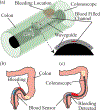
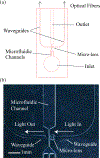


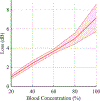
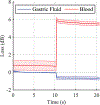
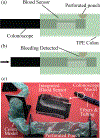
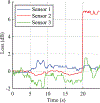
References
-
- Siegel RL, Miller KD, Jemal A, CA: A Cancer Journal for Clinicians 2020, 70, 1 7. - PubMed
-
- Bonjer HJ, Deijen CL, Abis GA, Cuesta MA, van der Pas MH, de Lange-de Klerk ES, Lacy AM, Bemelman WA, Andersson J, Angenete E, Rosenberg J, Fuerst A, Haglind E, New England Journal of Medicine 2015, 372, 14 1324. - PubMed
-
- Langan RC, Gotsch PB, Krafczyk MA, Skillinge DD, American Family Physician 2007, 76, 9 1323. - PubMed
-
- Baum S, Athanasoulis CA, Waltman AC, Galdabini J, Schapiro RH, Warshaw AL, Ottinger LW, American Journal of Roentgenology 1977, 129, 5 789. - PubMed
-
- Rasmussen PV, Dalgaard F, Gislason GH, Brandes A, Johnsen SP, Grove EL, Torp-Pedersen C, Dybro L, Harboe L, Münster A-MB, Pedersen L, Blanche P, Pallisgaard JL, Hansen ML, European Heart Journal 2020, 1–7. - PubMed
Grants and funding
LinkOut - more resources
Full Text Sources
